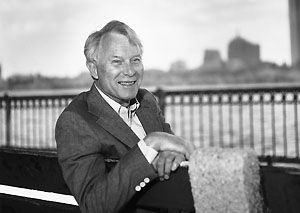
Fall
2000
![]()
Luminaries
Seven
notables contemplate the state of humanities, arts, and social sciences
at MIT and beyond.
![]()
![]()
Soundings is a publication of the School of Humanities, Arts, and Social Sciences at MIT
Comments and questions to shass-www@mit.edu
50 years on—plus ça change...?

Photo:
Graham G. Ramsay
Donald Blackmer is Professor of Political Science Emeritus. He joined the Center for International Studies in 1956 and became a member of the MIT faculty in 1961. He served as Associate Dean of the School of Humanities and Social Science from 1973 until 1980, the first Director of the Program in Science, Technology and Society from 1977 to 1980 and Head of the Department of Political Science from 1980 to 1988.
Reflecting on continuity and change in the School since the mid-1950s, I'm not inclined to the cynical view. The more things have changed, I'd say, the more different they've become. The weary bon mot around Building 14—about MIT's being paralyzed, not polarized, around science and engineering—no longer fits. While I was Associate Dean, the deck seemed subtly stacked against the School, mostly due to deep-seated student and faculty attitudes. Cultural imprints can be sticky and old attitudes doubtless persist, but the School has moved a long way toward full partnership in the Institute. Two dimensions of change particularly impress me: growth in the quality of faculty, and wider appreciation of the relevance of the School's work to the Institute.
With respect to faculty, the School has met the Institute on its own terms by insisting on excellence. In the early years, faculty quality was not universally high, partly because the School's appointment and promotion process was, shall we say, relaxed. Standards became more exacting in the 1970s, when a tough School Council review was introduced. Department Heads quickly learned that only strong candidates would survive the process and administrators, in turn, became better attuned to standards and styles of work in the School's disciplines.
The second dimension of change has narrowed the gap between "central" and "local" priorities. At MIT, new programs outside science and engineering need special justification. A 1957 report prepared by four distinguished scholars for John Burchard, the School's first dean, urged MIT "to revolutionize education in science and technology" by introducing study of their social, economic and political implications. Specifically, MIT was urged to create both a Department of Political Science and a "research and teaching center devoted to the history, philosophy, and sociology of science and technology." The first goal was realized soon thereafter, the second two decades later as the Program in Science, Technology, and Society (STS).
These two organizations, and the Center for International Studies from which Political Science emerged, represent for me prime examples of how new ventures, at first marginal to Institute life, have become more fully integrated. This has come about both because they have earned respect by doing high quality work and because the Institute itself—in response to change in the nation and the world—has enlarged its sense of mission.
The Center was founded in 1951 in the belief that the Institute, given the problem-solving ethic so fully demonstrated during the war, might be uniquely qualified to set up a social science research center to work on international issues. The social scientists recruited for the Center later became the nucleus of a Political Science Department distinctive in its disciplinary breadth, and committed to both policy studies and basic research. Department and Center members have since played key roles in the recent globalization of Institute programs and attitudes. Faculty in all Schools are now engaged in a range of research and educational commitments abroad that would have been unthinkable a few years ago.
Although far younger, the STS Program may be headed in a comparable direction. Like the Center, STS got off the ground because administrators saw a need to stimulate research on societal issues relating to science and technology and to help students grasp the cultural and social implications of their work. This required new faculty, primarily humanists, historians, and social scientists. Although a few collaborators were found among the engineering and science faculty, most were indifferent, and many skeptical of the value of having their work put under the microscope.
Recently the climate has changed. The Institute seems substantially more alert to the value that historical and critical analysis can bring to technological education and research. Collaboration between STS and other faculty is growing, and STS itself, through its graduate and fellowship programs, is contributing to the still-shallow pool of relevant specialists. Along with Political Science and CIS, STS seems to have found its niche in the Institute ecosystem.
![]()
Copyright © 2000 Massachusetts
Institute of Technology